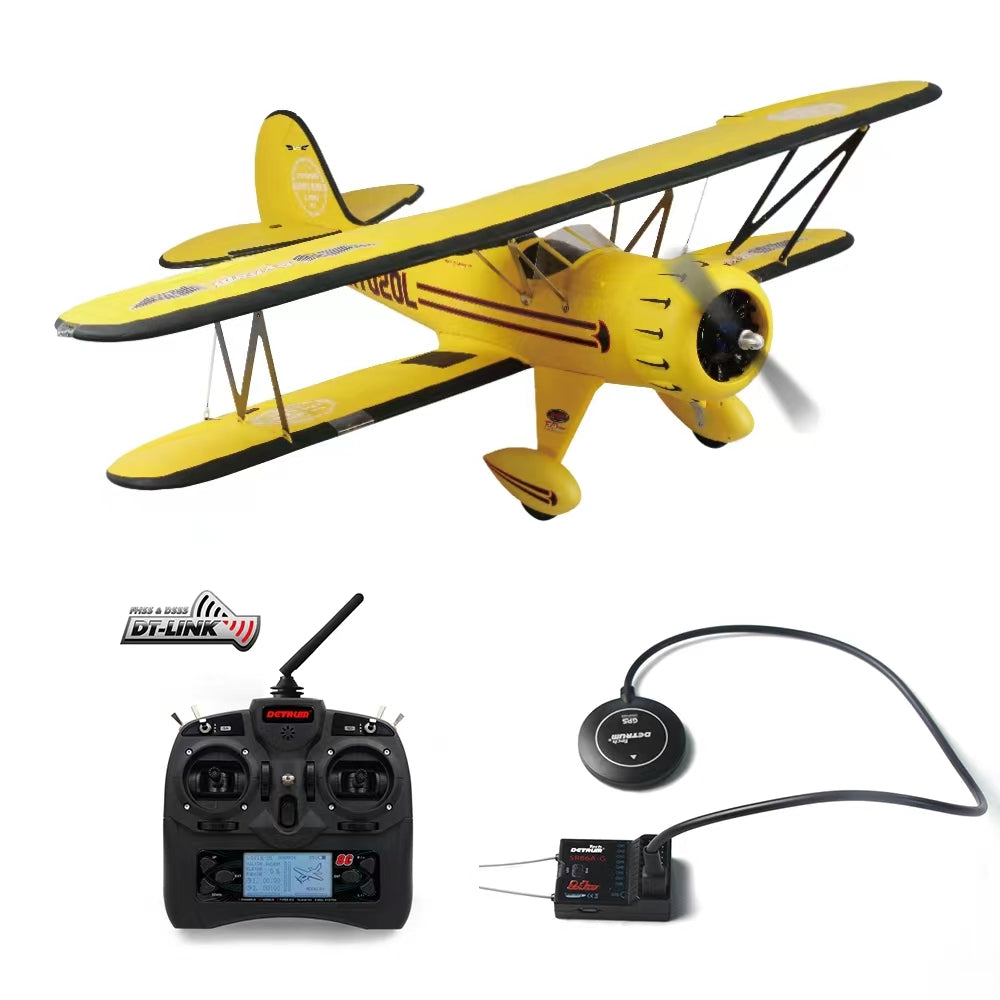RTF RC Planes for Beginners: A Complete Guide to Getting Started
Explore the world of RTF RC planes for beginners with this comprehensive guide. From understanding key features like stabilization systems and GPS autopilot, to my personal experience flying the Dynam Waco YMF-5D V2 Yellow SRTF-Pro, this article covers everything you need to know to get started in RC flying. Tips, FAQs, and recommendations included for smooth sailing.

Radio-controlled (RC) planes are a thrilling way to experience flight, and the ready-to-fly (RTF) models are a perfect option for beginners. With advancements in technology, RTF RC planes are easier to operate, more affordable, and can offer hours of fun and learning. In this article, I will guide you through the world of RTF RC planes for beginners, covering everything you need to know, including some hands-on experience with the Dynam Waco YMF-5D V2 Yellow SRTF-Pro equipped with the GAVIN-8CH TX & SR86A-G GPS Autopilot Receiver.
What Are RTF RC Planes?
An RTF (Ready-to-Fly) RC plane is a type of model aircraft that comes pre-assembled, so you don’t need to build it from scratch. All the major components—such as the motor, servos, receiver, and transmitter—are already installed and ready to go. For beginners, RTF RC planes are the ideal choice because they minimize the complexity and allow you to focus on learning to fly rather than spending time on assembly.
Why Choose RTF RC Planes for Beginners?
If you're new to the world of RC flying, RTF planes offer several benefits:
- Easy Setup: RTF models are designed to be ready for flight right out of the box. This means minimal setup time and fewer technical hurdles.
- Less Technical Knowledge Needed: You don’t need to be an expert in electronics, soldering, or building. RTF planes come pre-configured, making them more accessible.
- Built-in Stability Features: Many RTF planes include stabilization systems to help you maintain control, which is crucial when you’re just starting out.
- Affordable Options: There are many RTF planes on the market at different price points, allowing you to find one that fits your budget.
Choosing the Right RTF RC Plane for Beginners
When selecting an RTF RC plane as a beginner, you should consider several factors to ensure that it’s the best fit for you:
1. Size and Weight
Lighter planes are easier to handle and recover from crashes. Typically, planes with a wingspan of around 30 to 40 inches are ideal for beginners. Larger planes are more stable but can be more challenging to control, especially in windy conditions.
2. Stability Features
Many RTF RC planes come with built-in stabilization systems. These systems, like gyro stabilizers, help keep the plane stable in the air and prevent it from spinning out of control. Features like "self-leveling" or "auto-pilot" can be invaluable for those just starting out.
3. Durability
Planes with foam construction, such as EPO foam, are generally more durable and flexible when it comes to handling crashes. As a beginner, you’re likely to have a few mishaps, so durability is important.
4. Flight Time and Battery
Look for an RTF RC plane with a good balance of flight time (usually between 10-20 minutes) and a reasonable battery life. Batteries like LiPo (Lithium Polymer) are commonly used because they offer a good combination of power and light weight.
5. Price Range
As a beginner, you probably don’t want to make a huge investment right away. Fortunately, there are plenty of affordable options. However, keep in mind that investing in a quality plane will save you money in the long run, as cheaper models can sometimes be harder to control or break easily.
My Experience: Flying the Dynam Waco YMF-5D V2 Yellow SRTF-Pro
I’ve had the chance to fly the Dynam Waco YMF-5D V2 Yellow SRTF-Pro, a beautiful and powerful RTF plane, and I can tell you firsthand how it compares to other models. This plane is perfect for beginners who are looking for a more realistic and fun flying experience.
Features of the Dynam Waco YMF-5D V2:
- Scale Design: The Waco YMF-5D is modeled after the classic biplane, with stunning yellow detailing. It has a classic, vintage look that is both charming and practical.
- GPS Autopilot Receiver: One of the standout features is the SR86A-G GPS Autopilot Receiver, which adds an extra layer of ease and safety when flying. With this system, you get a "One-Click Return Home" feature, making it perfect for beginners.
- Powerful Motor and Servos: The powerful brushless motor, along with high-quality servos, provides smooth and responsive control. This helps you maintain control while learning to fly.
- Stabilization and Safety: The plane comes with integrated stabilization, so it is much more forgiving to beginners. In my experience, the plane is very stable even in moderate winds, which made it easy for me to handle.
When I took the Waco YMF-5D up for its first flight, I was impressed by how intuitive it was to control. Thanks to the GPS autopilot and stabilization features, I felt much more confident. Even when I made small mistakes, like over-correcting the controls, the plane corrected itself and stayed on course. And if I ever lost control, the One-Click Return Home feature brought it back safely without a hitch.
Key Features for Beginner RTF RC Planes
| Feature | Importance for Beginners | Example Planes |
|---|---|---|
| Stabilization Systems | Helps maintain control, reducing the risk of crashes. | Dynam Waco YMF-5D V2, HobbyZone AeroScout S2 |
| Durability | Planes made from EPO foam or similar materials are more crash-resistant. | E-flite Apprentice S 15e, FMS SkyTrainer 182 |
| GPS Autopilot | Provides features like "Return to Home" for easy recovery. | Dynam Waco YMF-5D V2, E-flite Cirrus SR22 |
| Flight Time | Longer flight time equals more fun per session. | E-flite UMX Timber, ParkZone Radian |
| Powerful Motor | Ensures stable and responsive flight. | Dynam Waco YMF-5D V2, HobbyZone Champ |
Frequently Asked Questions (FAQ)
1. How long does it take to learn to fly an RTF RC plane?
It varies depending on the individual, but most beginners can expect to become comfortable flying an RTF plane within 3 to 5 flying sessions. Starting with a plane that has stabilization features and practicing in calm weather will accelerate the learning process.
2. What should I do if my plane crashes?
If your RTF plane crashes, don't panic. First, inspect the plane for any major damage. RTF planes are designed to be crash-resistant, especially those made from foam. If the plane seems fine, you can reattach the battery, check for control surface movement, and attempt another flight.
3. Can I fly an RTF RC plane in windy conditions?
It’s best to avoid flying in strong winds as a beginner. Wind can make controlling the plane much more difficult. However, some models like the Dynam Waco YMF-5D V2 handle moderate winds well thanks to their stabilizing features.
4. Do I need to register my RC plane with the FAA?
In the United States, if your RC plane weighs over 0.55 pounds (250 grams), you’ll need to register it with the FAA. This is a requirement for any drone or model aircraft used for recreational purposes.
5. Can I upgrade my RTF RC plane later?
Yes! Many RTF planes allow for upgrades such as more powerful motors, improved servos, or additional flight stabilizers. This is great if you want to enhance the performance of your plane as your skills improve.
Conclusion: The Perfect Entry into RC Flying
If you’re just starting with RC planes, an RTF model is your best bet. It removes the complexities of assembly and allows you to dive straight into the fun of flying. The Dynam Waco YMF-5D V2 Yellow SRTF-Pro is an excellent example of what an RTF plane can offer—a smooth flying experience, helpful stability features, and the added safety of GPS autopilot. As you become more experienced, you can explore more advanced planes and techniques, but for now, enjoy the simplicity and thrill of flying an RTF RC plane.
Whether you're flying for fun or aiming to become a skilled pilot, starting with an RTF model can provide a rewarding and exciting introduction to the world of RC aviation.

 Paul Jonson
Paul Jonson 